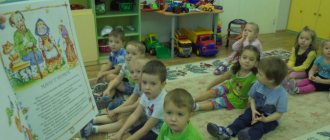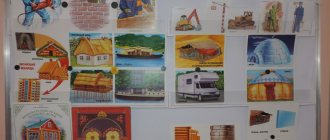technical map of an integrated lesson; methodological development (senior group)
me: Ella, in our group there is a corner of nature in which indoor plants grow.Guys, what are indoor plants? What conditions do plants need to grow?
Me: Guys, tell Ella what flowers there are in our corner of nature.
me: Describe what kind of stems, leaves, flowers the plants have.
Me: - In order for plants to be so beautiful, people need to look after them.
care. How to care for indoor flowers?
Me: People loosen the soil in pots so that the roots can breathe, wipe the leaves
with a damp cloth or fan with a brush. What kind of plant is fanned?
brush?). How often can you water a cactus? (once a week)
What types of plants are there?
Listen to a poem about how the girl Katya takes care of plants:
Katya took a watering can and watered all the flowers.
Let the little flowers drink some water. Our daughter wiped the leaves with a soft cloth.
Dust interferes with breathing and closes pores.
Me: Now we’ll go to the mat and rest a little.
PHYSMINUTE
"Growing magical flowers"
Children are squatting - They planted a seed in the ground, it rained and it began to grow.
Gradually they rise to their feet - The flower grew bigger and bigger and gained strength.
Hands palpate together above the head in the form of a “Bud” - The flower picks up a bud, the sun warms it.
Gradually they open their arms to the sides - And then the bud opened and we saw a beautiful flower!
Children lean forward and take a breath - But the flower is MAGICAL, whoever smells it and makes a wish, it will DEFINITELY come true!
I draw the children's attention to the easel on which the painting is located.
"In a corner of nature."
Me: Guys, what do you think the name of the picture is? (children’s reasoning)
Me: Let's look at the picture. Who do you see in the picture? Where did the children come? (to the corner
nature) What are the girls doing? (take care of flowers)
What flowers do you see in the picture? (violet, rosean, crassula)
Me: Right. There are also other beautiful plants. This is chlorophytum, fern,
Tradescantia.
What is the boy doing in the corner of nature? (he feeds the fish)
What fish do you see? (goldfish and swordtails)
There are also many plants in the aquarium.
Let's talk about the girl we see in the picture on the right.
How is she dressed? What is she doing? (a girl in a blue sundress in a white T-shirt
sprays a flower)
Me: Well done, tell me about the girl who is standing at the window.
(a girl in a blue sundress and a striped T-shirt is watering a fat plant
from a red watering can)
Who can tell you about the boy? (the boy in a striped jumpsuit is standing
at the aquarium and feeds the fish)
Me: Guys. you spoke very well about children. Look how beautiful it is in the corner
nature, how many flowers there are, how violets bloom, what juicy leaves the crassula has,
Crassula is popularly called the money tree. Children are well looked after
plants.
Technological map of integrated classes in the senior group
Technological map of an integrated lesson Name of the form of organization of the educational process: GCD Topic: “Spring chime” Author-developer: Lira Gennadievna Zotova, teacher of the MADOU No. 3 “Morozko”, Severodvinsk Age group: senior group Goal: to form children’s ideas about folk traditions spring meeting. Objectives: - expand children’s knowledge about folk toys, methods of making them, folk traditions of welcoming spring. Fix the names of folk instruments and musical groups. - develop communicative creativity and speech of children with the help of folklore. Develop rhythmic hearing, ensemble playing skills, and fine motor skills. — to cultivate interest in folk crafts, museum culture, and musical activities. Preliminary work: recalling proverbs about work with children, learning chants about spring, birds, singing “Cornflower”, looking at the album “Spring”, exhibits of toy birds in the group’s mini-museum. Equipment: stonefly bird, colored paper of different textures, scissors, diagram of the sequence of making crafts on a Russian scarf, “magic” chest, wood, musical instruments, Spring wreath. The technological map is drawn up in the form of a table with the following headings: - Stage, its duration - Objectives of the stage - Educational area - Form of organization of the educational process - Content of the activity - Result Stage, its duration: Introductory-organizational 1-2 min. Objectives of the stage: Organization of directed attention. Educational field Cognitive development, artistic and aesthetic development. Form of organization of the educational process: Frontal Content of activity: - teacher Playing the accordion of the musical fragment “Cornflower”, greeting, asking questions to children, establishing eye contact. - children Listening to a musical fragment, greeting. Result: Attracting focused attention. Internal motivation for activity. Stage, its duration: Update 3-5 minutes. Objectives of the stage: Updating existing knowledge and ideas about the signs of spring
Educational area: Cognitive development. Form of organization of the educational process: Frontal Content of activity: - teacher Questions for children. — What changes in nature occur in the spring? - children Participation in dialogue, answering the teacher’s questions, expressing their opinion based on their existing understanding. Recalling previously learned material. Result: Awakening positive emotions in children from the upcoming awakening of nature, reproducing the information necessary for the successful assimilation of the material. Stage, its duration: Expansion of existing ideas 5-7 min. Objectives of the stage: Enriching the horizons and cognitive interest of children. Mastering the concepts of “ensemble” and “orchestra”. Consolidating skills in playing musical instruments: metallophone, spoons, tambourine. Educational field: Cognitive development, artistic and aesthetic development. Form of organization of the educational process: Collective Content of activity: - teacher The teacher talks about the traditions of welcoming spring in Russia. The musical director asks questions about what an ensemble is, what musical instruments will play in the ensemble. High altitude display of melody. Organization of playing in the singing ensemble “Cornflower”. Answers on questions. - children Show the movement of the melody with your hand together with the teacher. Performing the song “Cornflower” and playing musical instruments in an ensemble. Result: Formed ideas about the image of spring in musical works, skills in playing in an ensemble, knowledge of the names of folk instruments and musical groups. Stage, its duration Dynamic pause 1-2 minutes. Objectives of the stage: Changing the type of activity, preventing fatigue Educational area: Social and communicative development, artistic and aesthetic development. Form of organization of the educational process: Frontal Content of the activity: - teacher Music director conducts the exercise “Birds of Migratory” - children Performing the exercise “Birds of Migratory” according to the demonstration. Result Relief of tension, emotional and physical release. Stage, its duration: Practical 8-10 minutes. Objectives of the stage: Mastering the methods of making poultry using the origami technique. Consolidating knowledge about folk toys, methods of making them, folk traditions of welcoming spring. Educational field: Cognitive development, artistic and aesthetic development. Form of organization of the educational process: Pair “strong-weak”, individual. Contents of the activity: - teacher Examination of the exhibit from the chest: what material is it made of. Viewing a collection of birds in a mini-museum. Draw children's attention to the fact that crafts are united by the love and hard work of the craftsmen. An offer to make a bird with your own hands to welcome spring. Teacher explaining the technique of making a stonefly bird. Organization of practical work. Organization of work in pairs. Providing necessary assistance and emotional support. - children Independent creative activity of children - making a “stonefly bird”. Result: Mastering the ability to work according to a diagram and pattern, verbal instructions, in pairs. Stage, its duration: Final. Consolidating acquired and existing knowledge - 3 min. Objectives of the stage: Development of communicative creativity, children's speech with the help of folklore. Generating interest in the content of GCD. Educational field: Social and communicative development, artistic and aesthetic development. Form of organization of the educational process: Collective Content of activity: - teacher Organization of children in a round dance by the teacher, pronouncing chants with children, choosing a child for the role of Spring. The musical director conducts the round dance “Dear Land”. - children Reciting chants about spring and birds, performing movements in a round dance as shown by the music director. Result Formation of ideas about folk traditions of welcoming spring. Stage, its duration: Reflection 3 min. Objectives of the stage: Generalization of the child’s ideas about the world around him. Educational field: Social and communicative development. Form of organization of the educational process: Frontal, individual. Contents of the activity: - teacher Summing up the results of the GCD from different points of view, designing children's creative works on a tree. — children Statements about the information received, the quality of the work performed, their emotional state. Result: Formation of cognitive actions. Awareness of oneself as a participant in the cognitive, creative process.
We recommend watching:
Drawing lesson in the preparatory group on the topic Spring Summary of the final integrated lesson in the senior group Integrated lesson in the senior group on design Summary of the lesson in the senior group on the topic “Under the Shynarak of Friendship”
Similar articles:
Scenario for an integrated lesson in the senior group
Complex lesson in the senior group of kindergarten according to the Federal State Educational Standard
Summary of an integrated lesson in the senior group of kindergarten on the topic: Day
Summary of an integrated lesson – travel on the topic “Winter” in the senior group
Summary of an integrated lesson on the topic “Trees” in the senior group




